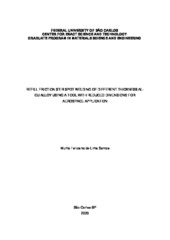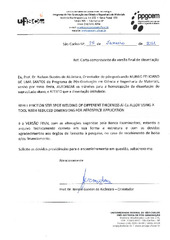| dc.contributor.author | Santos, Murilo Feliciano de Lima | |
| dc.date.accessioned | 2021-03-05T16:22:54Z | |
| dc.date.available | 2021-03-05T16:22:54Z | |
| dc.date.issued | 2020-11-12 | |
| dc.identifier.citation | SANTOS, Murilo Feliciano de Lima. Refill friction stir spot welding of different thickness Al-Cu alloy using a tool with reduced dimensions for aerospace application. 2020. Dissertação (Mestrado em Ciência e Engenharia de Materiais) – Universidade Federal de São Carlos, São Carlos, 2020. Disponível em: https://repositorio.ufscar.br/handle/ufscar/13927. | * |
| dc.identifier.uri | https://repositorio.ufscar.br/handle/ufscar/13927 | |
| dc.description.abstract | Refill Friction Stir Spot Welding has grown as an interesting alternative to conventional joining techniques in recent years, especially when it comes to high strength aluminum alloys. Although current results show promise, there are still areas in which the body of knowledge is lacking and there are challenges for
further investigation. This work tackled some of those challenges by investigating and optimizing the refill FSSW process for 2A12 (AA2024) aluminum alloy using a tool with reduced dimensions to weld an unconventional sheet configuration (0.8mm to 3mm in thickness). This was achieved using Design of Experiments coupled with Analysis of Variance. In addition, the influence of process parameters on microstructural geometrical features and in weld performance was studied, and Plunge Depth was found to be the most significant process variable when it comes to weld strength. Crack was shown to start around the hook region and propagate through two possible paths, the SZ/TMAZ interface or the aluminum rich layer in the stir zone. These two paths generated two main fracture modes, and the pullout mode was associated with the optimal condition. Given that a 2xxx series aluminum alloy was used, natural aging was investigated, and found to be influential in local mechanical properties through hardness tests. This influence, however, did not translate to Lap Shear Strength, as samples with different aging levels presented similar properties. Finally, the wear behavior of the tool was studied with increasing welding cycles. Tool geometry was significantly affected by wear, and this impacted weld surface with time, generating increasing notches on the edge of the stir zone. Those notches reduced the effective thickness of the top sheet, and consequently contributed to premature failure at inferior loads. | eng |
| dc.description.sponsorship | Conselho Nacional de Desenvolvimento Científico e Tecnológico (CNPq) | por |
| dc.language.iso | eng | eng |
| dc.publisher | Universidade Federal de São Carlos | por |
| dc.rights | Attribution-NonCommercial-NoDerivs 3.0 Brazil | * |
| dc.rights.uri | http://creativecommons.org/licenses/by-nc-nd/3.0/br/ | * |
| dc.subject | Solid state welding | eng |
| dc.subject | Refill FSSW | eng |
| dc.subject | 2A12 | eng |
| dc.subject | Design of experiments | eng |
| dc.subject | ANOVA | eng |
| dc.subject | Natural aging. | eng |
| dc.subject | Tool wear | eng |
| dc.subject | Soldagem no estado sólido | por |
| dc.subject | Planejamento de experimentos | por |
| dc.subject | Envelhecimento natural | por |
| dc.subject | Desgaste de ferramenta | por |
| dc.title | Refill friction stir spot welding of different thickness Al-Cu alloy using a tool with reduced dimensions for aerospace application | eng |
| dc.title.alternative | Soldagem a ponto por fricção de liga de Al-Cu de diferentes espessuras utilizando ferramenta com dimensões reduzidas para aplicação aeroespacial | por |
| dc.type | Dissertação | por |
| dc.contributor.advisor1 | Alcântara, Nelson Guedes de | |
| dc.contributor.advisor1Lattes | http://lattes.cnpq.br/3123107570992184 | por |
| dc.contributor.advisor-co1 | Plaine, Athos Henrique | |
| dc.contributor.advisor-co1Lattes | http://lattes.cnpq.br/8992899102845408 | por |
| dc.description.resumo | A soldagem por fricção por ponto (Refill FSSW) tem se mostrado uma alternativa interessante para substituir métodos de soldagem convencionais nos últimos anos, especialmente em se tratando de ligas de alumínio. Apesar de as pesquisas serem promissoras, ainda há muitas áreas inexploradas no tema. O presente projeto visou avaliar algumas dessas áreas através da investigação e otimização do processo de Refill FSSW para a liga de alumínio 2A12 (AA2024) usando uma ferramenta de dimensões reduzidas para soldar uma configuração de chapas não convencional (0,8mm com 3,0mm). Isso foi realizado através da utilização de Planejamento Estatístico de Experimentos e Análise de Variância. Adicionalmente, a influência dos parâmetros do processo em características microestruturais geométricas e na performance das soldas foi estudada, e a
profundidade de penetração apresentou-se como a variável mais significante no que diz respeito à resistência mecânica das soldas. Observou-se que trincas se iniciam no hook e se propagam através de dois possíveis caminhos, a interface
entre SZ e TMAZ ou a camada rica em alumínio no centro da solda. Esses dois caminhos possíveis resultam em dois modos de fratura. O envelhecimento natural foi investigado, e apontado como influente em propriedades mecânicas
locais através de ensaios de dureza. Essa influência, contudo, não se traduziu para a resistência ao cisalhamento, uma vez que amostras em diferentes estágios do envelhecimento apresentaram propriedades similares. Por fim o comportamento de desgaste da ferramenta foi estudado com o aumento dos ciclos de soldagem. A geometria da ferramenta foi significativamente afetada
pelo desgaste, e impactou na superfície das soldas, gerando indentações na borda externa da zona de mistura. Essas indentações reduziram a espessura efetiva das chapas e contribuíram para a falha precoce em cargas inferiores. | por |
| dc.publisher.initials | UFSCar | por |
| dc.publisher.program | Programa de Pós-Graduação em Ciência e Engenharia de Materiais - PPGCEM | por |
| dc.subject.cnpq | ENGENHARIAS::ENGENHARIA DE MATERIAIS E METALURGICA::METALURGIA DE TRANSFORMACAO | por |
| dc.subject.cnpq | ENGENHARIAS::ENGENHARIA DE MATERIAIS E METALURGICA::METALURGIA FISICA | por |
| dc.description.sponsorshipId | CNPq: 134356/2019-5 | por |
| dc.publisher.address | Câmpus São Carlos | por |
| dc.contributor.authorlattes | http://lattes.cnpq.br/9579392245937073 | por |


